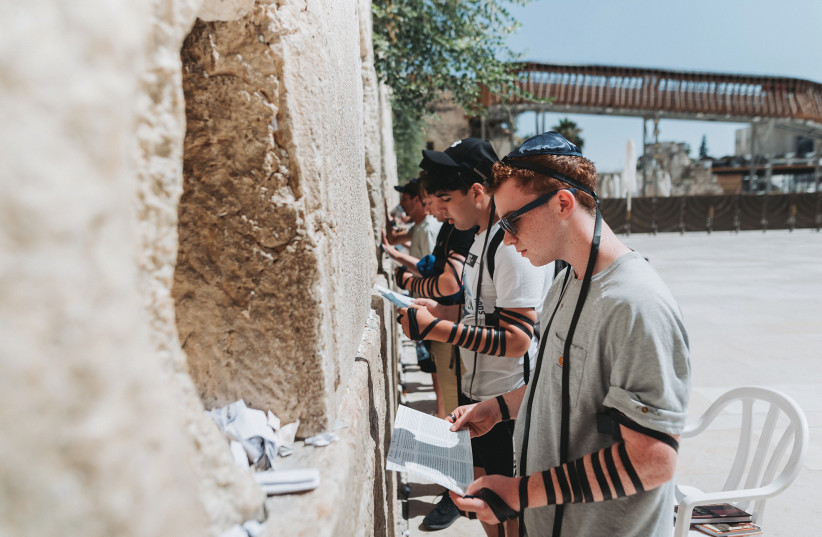The Jewish calendar has its own metabolism and Jerusalem is at its epicenter.
That incredulous fact is brought to our attention most specifically during the period known as The Three Weeks – the three weeks of summer we are now living through. The three weeks that begin with the 17th day of the Jewish month of Tamuz and culminate on the ninth day of the Jewish month of Av. Three weeks that are bookended by days on which we fast.
And why do we fast? We fast as a way of remembering and of mourning. Remembering the Temples of Jerusalem. Mourning their destruction.
The 17th of Tamuz commemorates the date on which the walls of the city of Jerusalem were breached during the Second Temple period. The ninth day of Av memorializes the destruction of both the First and Second Temples.
Jewish tradition – using the Jewish calendar as its vehicle, has created a yearly mourning period for Jerusalem, symbolized most strongly, most devoutly, most obviously by the Temples. The place where Jews came to deliver their long-ago sacrifices in service to God.

Jewish traditions were established to dictate behaviors that force Jews to not only remember, but to feel, the destruction of Jerusalem – through the Jewish calendar. Traditions are in place today so that our collective memory never forgets what happened, what befell the Jewish people those many years ago.
And not merely during these three summertime weeks.
The Jewish month of Tevet falls during wintertime. And on the 10th day of Tevet, Jews fast, once again. It is on that day in history that the Babylonians besieged the city of Jerusalem. The Jewish month of Tishrei heralds the fall season. And on the third day of Tishrei, the day after Rosh Hashanah, we fast yet again. All connected to Jerusalem.
The third day of Tishrei is the Fast of Gedalia. It is the day when Gedalia, the Babylonian-appointed king of Jerusalem, was assassinated. And Jews fast because Gedalia, king of Jerusalem, was “good to the Jews.” His assassination was a loss to the Jews of Jerusalem, to their community, and to their communal safety. His assassination marks the end of Jewish life in Jerusalem.
Jews fast to remember the loss of King Gedalia of Jerusalem. So good was he to the Jews, that we even proudly name our children after a non-Jewish king.
While the Jewish calendar dictates that we mourn Jerusalem, it also dictates that we celebrate Jerusalem. Three times a year, on the three pilgrimage holidays, Jews from all of Israel traveled to Jerusalem to deliver their sacrifices at the Temple. And those are the three holidays of Sukkot in the fall, of Passover in the early spring, and of Shavuot which closes out the spring and begins the summer season. They are the three pilgrimage holidays – holidays during which Jews ascended to Jerusalem.
Almost every Jewish holiday is Jerusalem based. The only exception – a glaring exception – is Purim. Hanukkah, the Festival of Lights, commemorates the rededication of the Temple of Jerusalem. The Jewish New Year, Rosh Hashanah, and the fast of Yom Kippur, the holiest day in the entire Jewish calendar, are certainly Jerusalem-centric. Their liturgy speaks of the Temple and of Jerusalem.
Jerusalem is at the very soul of Judaism. Removing Jerusalem from Judaism would be a serious mistake. It is a lesson the Reform movement learned only too well.
Failed attempts to separate Jerusalem from Judaism
In 1885, the Reform Movement attempted to deracinate Jerusalem from Judaism. And it failed. At a conference in Pittsburgh, Reform Judaism tried to modernize Judaism. They established eight points.
Article 5 of the Pittsburgh platform is critical, as it removed the centrality of Israel and Jerusalem. It read: “We recognize, in the modern era of universal culture of heart and intellect, the approaching of the realization of Israel’s great messianic hope for the establishment of the kingdom of truth, justice, and peace among all men.
“We consider ourselves no longer a nation, but a religious community, and therefore expect neither a return to Palestine, nor a sacrificial worship under the sons of Aaron, nor the restoration of any of the laws concerning the Jewish state.”
For the next hundred years, elements within the Reform Movement back-peddled the Pittsburgh Platform. And eventually, they joined the Zionist movement.
Jerusalem is not only central to Judaism, it is also a synonym for all of Israel. The best evidence of this is the Jerusalem Talmud. The Jerusalem Talmud was never composed in Jerusalem. It received its name because, quite simply, Jerusalem is a metaphor for all of Israel.
Jerusalem is the foundation stone for all of Judaism. It is where Judaism developed as a culture, as a people, a society, a nation, and a religion. And our Jewish calendar recognizes its value.
And that is why, not only at the conclusion of every Passover Seder, but also at the conclusion of the High Holy Day Yom Kippur service, right after proclaiming the greatness of God, right before the blowing of the shofar, Jews all across the world proclaim “Next Year in Jerusalem.”
The writer is a social and political commentator. Watch his TV show, Thinking Out Loud, on the Jewish Broadcasting Service. His latest book is Thugs.
